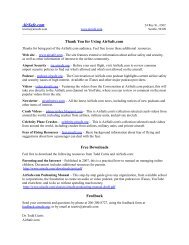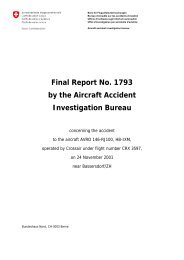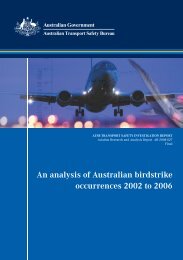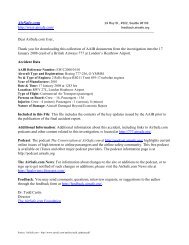Event Sequence Analysis - Bird Strikes - Airline Safety and Security ...
Event Sequence Analysis - Bird Strikes - Airline Safety and Security ...
Event Sequence Analysis - Bird Strikes - Airline Safety and Security ...
You also want an ePaper? Increase the reach of your titles
YUMPU automatically turns print PDFs into web optimized ePapers that Google loves.
Figure 1: <strong>Event</strong> <strong>Sequence</strong> Map Structure<br />
Below is the basic structure of an event sequence map for a series of events that lead to a pair of<br />
unique consequences.<br />
<strong>Event</strong> 1<br />
<strong>Event</strong> 2<br />
<strong>Event</strong> 3A<br />
<strong>Event</strong> 4A<br />
Consequence 1<br />
<strong>Event</strong> 3B<br />
<strong>Event</strong> 4B<br />
Consequence 2<br />
In this example, each line represents one event <strong>and</strong> the indentations are a visual reminder that the<br />
events take place in a specific sequence. The rightmost indented event represents the outcome. The<br />
line connecting <strong>Event</strong>s 3A <strong>and</strong> 3B in Figure 1 illustrates that the sequence branches at the point into<br />
two possible directions. The consequences at the end of these different paths can either be the same<br />
consequence arrived at through different sequences of events or they could be different consequences.<br />
In Figure 1, there is a different unique sequence associated with Consequence 1 <strong>and</strong> 2, but both<br />
sequences would share <strong>Event</strong>s 1 <strong>and</strong> 2.<br />
The probability of any one event occurring may or may not be dependent on the sequence of events<br />
that preceded it. Consider the following sequence: (1) the flight crew sees a large flock of birds during<br />
the takeoff roll, but are unable to take any kind of evasive action such as rejecting the takeoff (e.g.,<br />
after V1 but before Vr); (2) after hearing multiple impact sounds from these birds, the engine<br />
instruments indicate a substantial drop in thrust on one engine; <strong>and</strong> (3) the crew rejects the takeoff; the<br />
probability of the second event would be entirely independent of the first event, but the probability of<br />
the third event would be a function of the first two events. This is because in airline operations, pilots<br />
are trained to continue the takeoff if there is a loss of thrust on a single engine after reaching V1, unless<br />
they have reason to believe that a rejected takeoff is a better option than continuing the takeoff.<br />
From my industry experience where I analyzed numerous accidents <strong>and</strong> incidents involving either bird<br />
strikes or rejected takeoffs, I found that the pilots sometimes made decisions based on information that<br />
is not reflected in their cockpit instruments. In the context of bird strikes, that information may include<br />
the visual presence of birds coupled with sounds of impact on the aircraft. There have been cases,<br />
including the 1986 A300 bird strike accident analyzed in this report, where pilot sensations such as<br />
sighting birds, hearing impacts, or feeling engine vibration, led the flight crew to make a rejected<br />
takeoff decision that led to an accident, even though the cockpit instruments correctly indicated that<br />
the aircraft could safely take off.<br />
Comparison of Eight Serious <strong>Bird</strong> Strike Accidents Page 4<br />
Dr. Todd Curtis , AirSafe.com Foundation Revised 1/22/09











